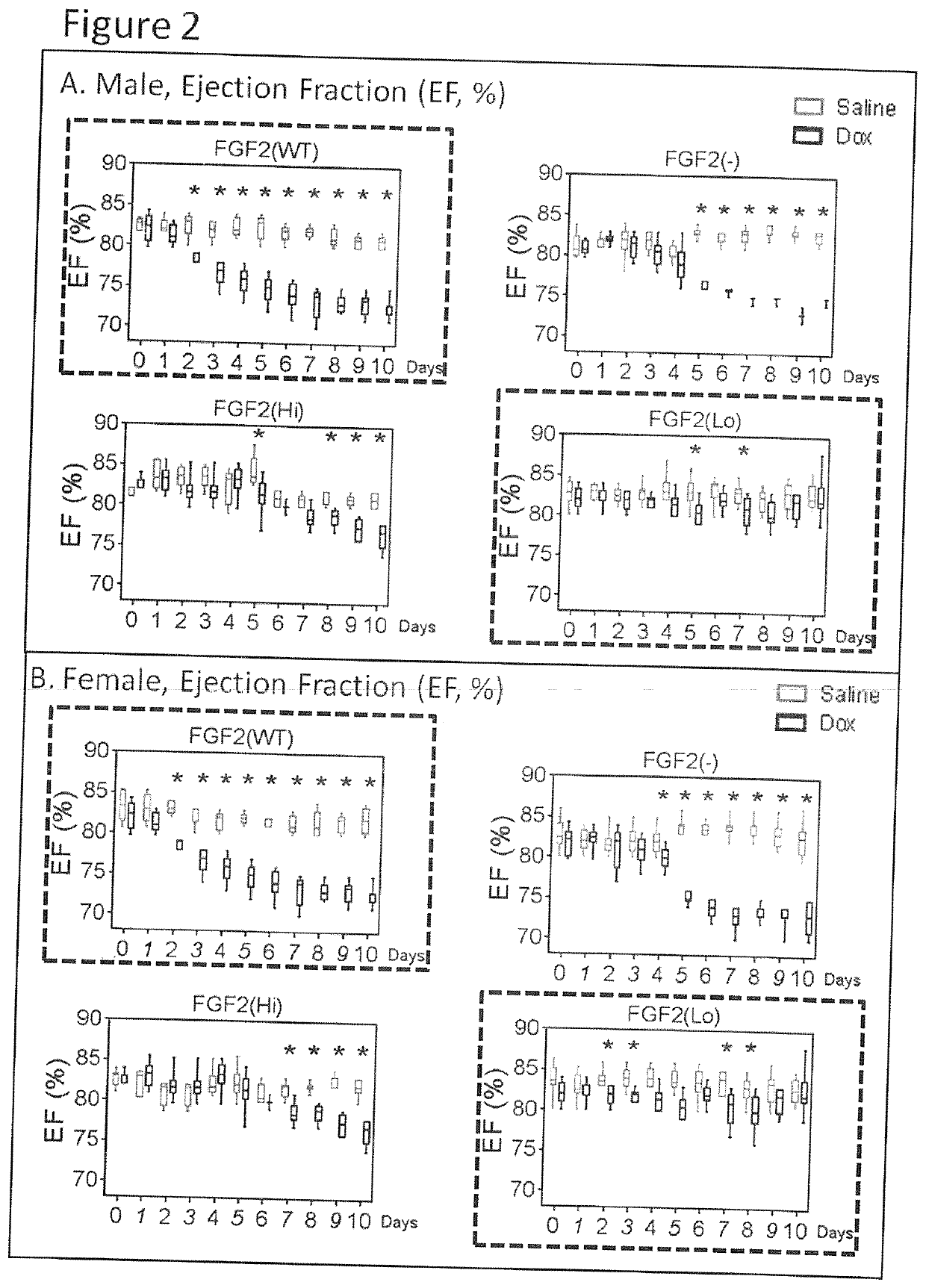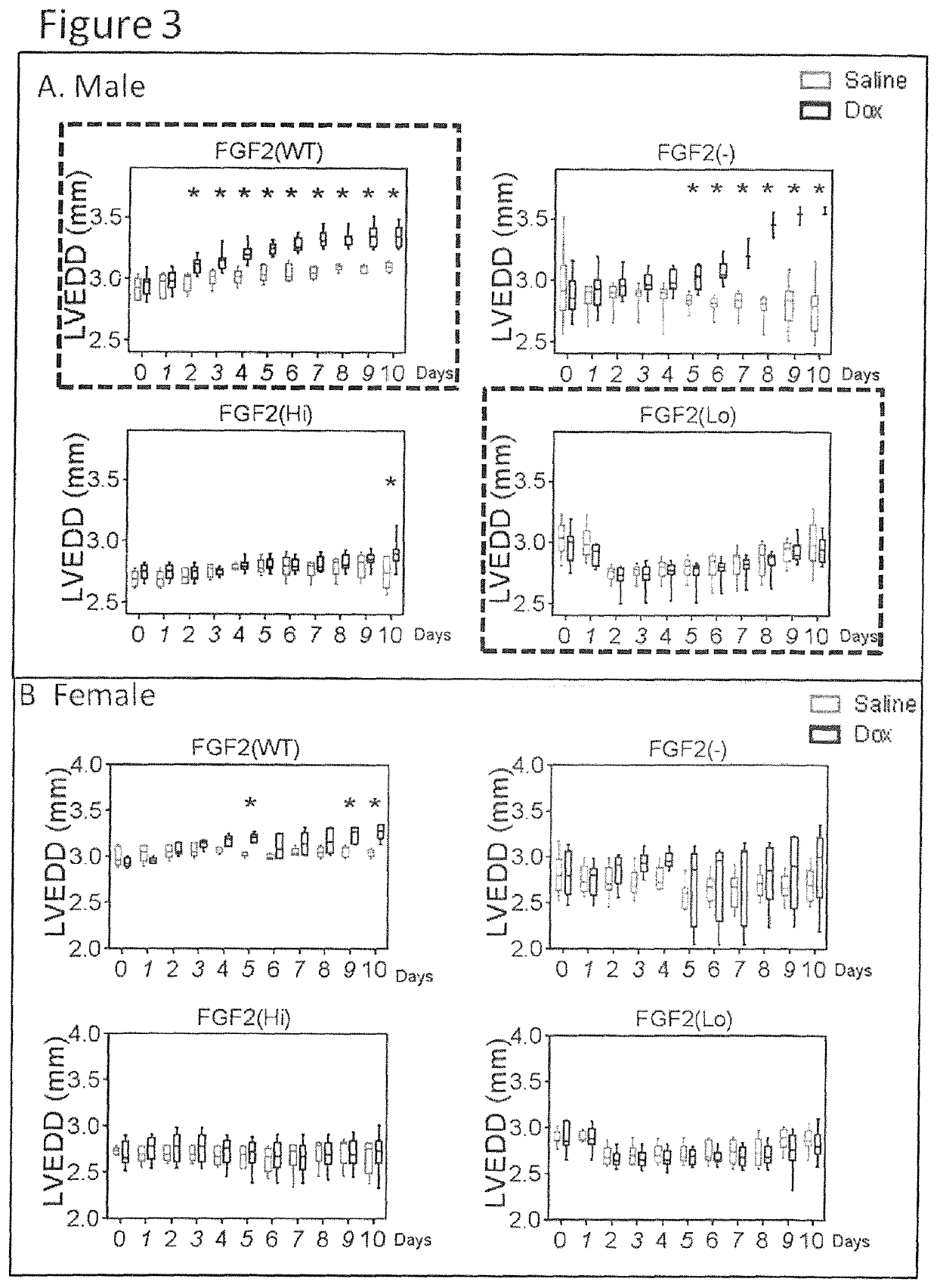Elimination or Neutralization of Endogenous High Molecular Weight FGF-2 Increases Cardiac Resistance to Doxorubicin-Induced Damage
a high molecular weight, cardiac technology, applied in the direction of anti-noxious agents, drug compositions, peptides, etc., can solve the problem of reducing cardiac vulnerability to dox treatment, and achieve the effect of reducing the severity of cardiotoxicity
- Summary
- Abstract
- Description
- Claims
- Application Information
AI Technical Summary
Benefits of technology
Problems solved by technology
Method used
Image
Examples
examples
[0091]With every heart-beat, blood is pumped to the body to meet the ongoing oxygen and nutrient requirements of the body organs. In healthy individuals at rest, the heart pumps out blood with a force at baseline levels; when the individual's activity increases, the heart increases its pumping power to meet the increased needs. The term ‘Ejection Fraction, EF, is a measure of the pumping ability of the heart, and is measured by ultrasound (Echocardiography). EF represents the percentage of the blood pumped out from the heart at the time of measurement. In case of heart stress and damage the heart's ability to pump blood is compromised / decreased and this is measured as a decrease in EF values by echocardiography. In short, a drop in EF suggests that the heart contractile function is damaged, which may be the result of heart muscle injury.
[0092]If the heart is diseased (possibly by formation of scar tissue, or fibrosis, and / or a weakening of muscle strength), it presents reduced abili...
example i
Characteristics of the FGF2 Mouse Models
[0094]FGF2(−), FGF2(Hi), and FGF2(Lo) genetically engineered mice have been characterized previously (11-13). With the exception of FGF2(−) lacking all FGF2, the remaining groups expressed comparable levels of total FGF2, regardless of isoform composition. All groups had normal pregnancies and did not display any gross morphological abnormalities. Differences were observed in baseline body weights. In males, FGF2(Lo) mice had smaller body weight, by 8%, compared to the FGF2(WT) group, while the FGF2(−) and FGF2(Hi), groups were heavier, by 12% and 15%, respectively, compared to FGF2(WT). A broadly similar pattern was observed amongst the female groups. Thus, the absence of Lo-FGF2, in the FGF2(−), and FGF2(Hi) groups was associated with overall heavier body weights.
[0095]Baseline echocardiography measurements indicated that systolic function and LVEDD were within the normal range in all groups both males and females.
example ii
of Dox on Mortality and Body Weight
[0096]Dox-induced mortality was highest (70%) in male FGF2(−) mice, followed by female FGF2(−) mice at 30%, by day 10 post-Dox. No deaths occurred in any of the remaining female groups, or in any of the sham groups. The post-Dox mortality of male FGF2(Hi), and male FGF2(WT) was at 20% and 10%, respectively. Dox induced some weight loss in all groups.
PUM
| Property | Measurement | Unit |
|---|---|---|
| molecular weight | aaaaa | aaaaa |
| molecular weight | aaaaa | aaaaa |
| molecular-weight | aaaaa | aaaaa |
Abstract
Description
Claims
Application Information
 Login to View More
Login to View More - R&D
- Intellectual Property
- Life Sciences
- Materials
- Tech Scout
- Unparalleled Data Quality
- Higher Quality Content
- 60% Fewer Hallucinations
Browse by: Latest US Patents, China's latest patents, Technical Efficacy Thesaurus, Application Domain, Technology Topic, Popular Technical Reports.
© 2025 PatSnap. All rights reserved.Legal|Privacy policy|Modern Slavery Act Transparency Statement|Sitemap|About US| Contact US: help@patsnap.com



